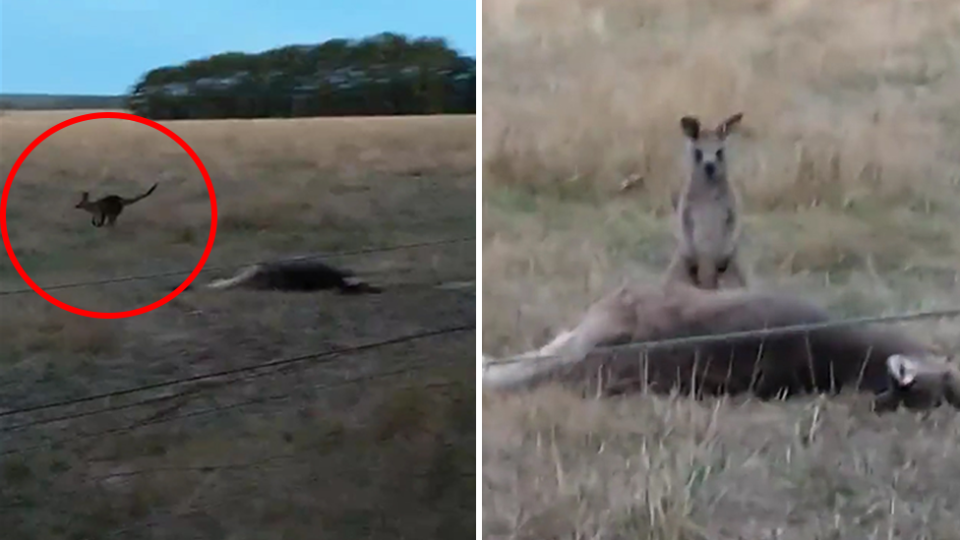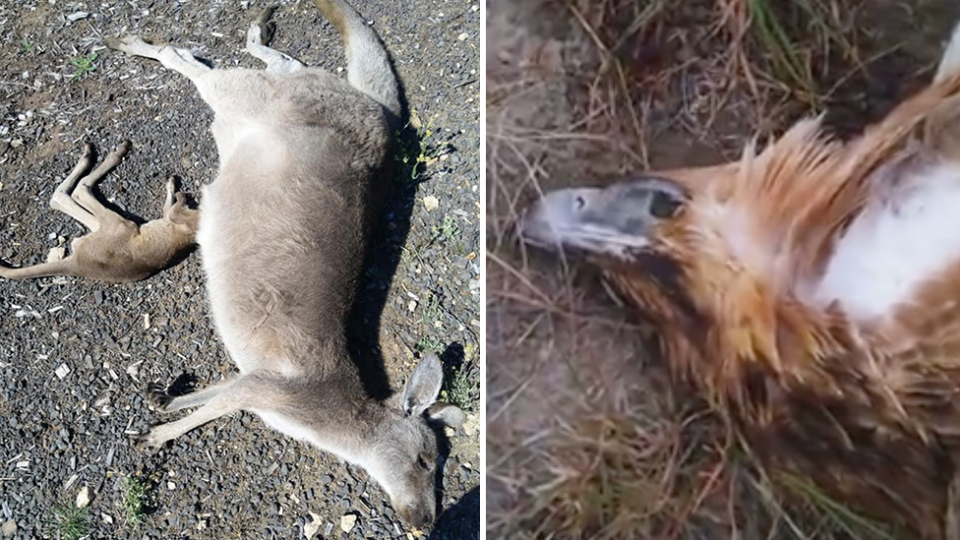'Like a war zone': Woman's 'nightmare' after moving to the bush
WARNING – DISTURBING CONTENT: A British woman who moved to the Victorian countryside for a “tree change” has been left feeling too frightened to leave her house.
Lynn Hosking-Moore moved to a 70-acre block at Hamilton, 258km west of Melbourne, hoping to find a quiet place to enjoy nature, but instead she describes the lifestyle as a “nightmare”.
The 68-year-old told Yahoo News Australia that most nights she struggles to sleep while landholders in the area hunt down wildlife, shooting kangaroos that leave her sanctuary and venture onto private properties.
When the gun smoke has cleared, Ms Hosking-Moore says she often wakes to find the bodies strung up on fences.
“It was supposed to be a tree change and a relaxing end of my life sort of thing, doing nothing and living with wildlife,” she said.
“It’s become like a war zone - there’s gunfire every night, especially during the winter.
“Then there’s just dead kangaroos everywhere, this killing’s got to stop.”

‘Why is this allowed to happen?’
After trying unsuccessfully to reason with local property owners about the shooting, Ms Hosking-Moore began feeling depressed, so she purchased a mobile phone with a camera so she could document her ordeal.
It wasn’t long before she came across a distressing sight not far from her property and started filming.
Her video begins with a young, furred joey hopping around a paddock.
“Shot its mum, they’ve shot its f*****g mum,” she alleges from behind the camera.

The joey bounces around the paddock and then stops in front of her dead mother.
“How’s that going to survive now?” Ms Hosking-Moore asks.
Her voice starts to quiver as the baby tries to get back inside her dead mother’s pouch.
Last Tuesday, the 68-year-old took to Facebook to vent her anger and posted the video to Facebook.
“She was desperately trying to get back into the safety of her mother's pouch,” she wrote.
“Oh God. Why is this allowed to happen?”
The post has been shared more than 350 times online, and amassed a long list of comments from people angered by the contents of the video.

“Isn't there a law forbidding this?” asked one person.
“Animals have families and feelings. This needs to be stopped,” wrote someone else.
Ms Hosking-Moore alleged in her post that she wasn’t allowed to go into the paddock and take the joey into her care.
She does not know its fate.
Code of practice recommends shooters avoid killing mothers
In most Australian states, hunters can commercially shoot kangaroos and sell the carcasses, while landholders can also apply for permits to kill wildlife on their properties.
Under the kangaroo shooters code of practice, if a shooter kills a female with joey, they must euthanise it to avoid it suffering a drawn out death.
“All target female kangaroos and wallabies, including injured and sick animals, must be thoroughly examined for pouch young,” the guide states.
“If a pouch young or young at foot is present, euthanasia must be carried out.”
The code goes on to specify that shooters should avoid killing female kangaroos and wallabies “where it is obvious have dependent young except in special circumstances.”
Those circumstances include euthanising sick or injured animals.
Alleged breaches of the code are investigated by state authorities unless the alleged breach involves overseas export, in which case authority falls to the federal department of environment.
‘They’ve got nowhere to go’: Carnage on the roads
Despite the stress, Ms Hosking-Moore feels she cannot move away from her block, as the property she moved to in 2001 is now her home.
She fears that if she sold it, the purchaser could could easily get permits from the Victorian government to kill the friendly animals on her block.
“The kangaroos are doing no harm to anybody and they’re just getting wiped out,” she said.
“They’ve got nowhere to go.
“Kangaroos are getting smaller and smaller because they’ve killed all the big ones.”

Her daily drive into town compounds her stress.
Each morning she passes the bodies of marsupials, birds and other dead animals hit on the road overnight.
Hoping to get drivers to slow down, she has shared images of a dead kangaroo and her joey and a wedge-tailed eagle – all found by the roadside.
'War for public opinion': Vet furious as government announces duck hunt amid wildlife crisis
'What a waste of a life': Dog walker makes 'terrible' discovery at popular lake
'$20 per scalp': Dingo bounty flyer sparks concern over animal's future
“These are all hit and runs all left still alive by uncaring drivers near my home in the last couple of weeks,” she wrote besides the photographs.
“This is just not right.
“Nothing should be left lying hurt on the roads. Nothing.”
As Ms Hosking-Moore learns more about using a digital camera and publishing on social media, she hopes she can continue to spread awareness and create change.
“If I see any shooting I’m straight out the door,” she said.
“I’ll sit out in the cold and the rain, I don’t know if (the shooters) think I’m a pest.
“Everyone just seems so determined to kill everything.”
Do you have a story tip? Email: newsroomau@yahoonews.com.
You can also follow us on Facebook, Instagram and Twitter and download the Yahoo News app from the App Store or Google Play.




